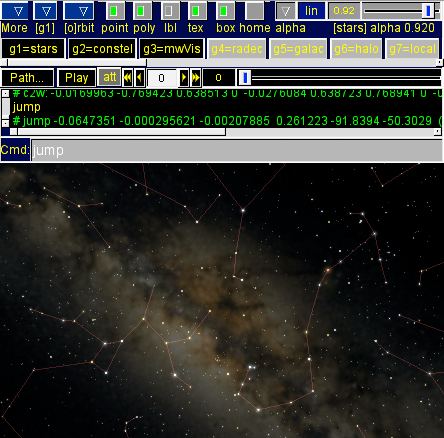The Digital Universe Atlas, developed by the American Museum of Natural History’s Hayden Planetarium with support from NASA, incorporates data from dozens of organizations worldwide to create the most complete and accurate 3D atlas of the Universe from the local solar neighborhood out to the edge of the observable Universe.
Digital Universe Atlas is a standalone 4-dimensional space visualization application built on the programmable Partiview data visualization engine.
Explore the nearby stars, star clusters, nebulae, extrasolar planets, nearby galaxy clusters, the Sloan Digital Sky Survey, and much more. See the night sky as it appears across the spectrum, from radio and infrared, to visible, and even in Gamma rays.
Digital Universe shares the capacity to visualize space from points outside Earth. Building on work by Japan’s RIKEN, its planet renderings and zoom visualizations can match or exceed Celestia.
Features include:
- Extremely powerful visualization engine.
- High quality planet rendering.
- Zoom visualizations.
- Built on Partiview.
- An industrial strength, interactive, mono- or stereoscopic viewer for 4-dimensional datasets.
- Highly accurate visualization from distances beyond the Milky Way galaxy is integral to the softwar.
Website: www.amnh.org/research/hayden-planetarium/digital-universe/download
Support:
Developer: American Museum of Natural History’s Hayden Planetarium, National Aeronautics and Space Administration
License: Illinois Open Source License
The Digital Universe Atlas has spun off a commercial-grade planetarium platform from SCISS called Uniview.

| Popular series | |
|---|---|
| The largest compilation of the best free and open source software in the universe. Each article is supplied with a legendary ratings chart helping you to make informed decisions. | |
| Hundreds of in-depth reviews offering our unbiased and expert opinion on software. We offer helpful and impartial information. | |
| The Big List of Active Linux Distros is a large compilation of actively developed Linux distributions. | |
| Replace proprietary software with open source alternatives: Google, Microsoft, Apple, Adobe, IBM, Autodesk, Oracle, Atlassian, Corel, Cisco, Intuit, SAS, Progress, Salesforce, and Citrix | |
| Awesome Free Linux Games Tools showcases a series of tools that making gaming on Linux a more pleasurable experience. This is a new series. | |
| Machine Learning explores practical applications of machine learning and deep learning from a Linux perspective. We've written reviews of more than 40 self-hosted apps. All are free and open source. | |
| New to Linux? Read our Linux for Starters series. We start right at the basics and teach you everything you need to know to get started with Linux. | |
| Alternatives to popular CLI tools showcases essential tools that are modern replacements for core Linux utilities. | |
| Essential Linux system tools focuses on small, indispensable utilities, useful for system administrators as well as regular users. | |
| Linux utilities to maximise your productivity. Small, indispensable tools, useful for anyone running a Linux machine. | |
| Surveys popular streaming services from a Linux perspective: Amazon Music Unlimited, Myuzi, Spotify, Deezer, Tidal. | |
| Saving Money with Linux looks at how you can reduce your energy bills running Linux. | |
| Home computers became commonplace in the 1980s. Emulate home computers including the Commodore 64, Amiga, Atari ST, ZX81, Amstrad CPC, and ZX Spectrum. | |
| Now and Then examines how promising open source software fared over the years. It can be a bumpy ride. | |
| Linux at Home looks at a range of home activities where Linux can play its part, making the most of our time at home, keeping active and engaged. | |
| Linux Candy reveals the lighter side of Linux. Have some fun and escape from the daily drudgery. | |
| Getting Started with Docker helps you master Docker, a set of platform as a service products that delivers software in packages called containers. | |
| Best Free Android Apps. We showcase free Android apps that are definitely worth downloading. There's a strict eligibility criteria for inclusion in this series. | |
| These best free books accelerate your learning of every programming language. Learn a new language today! | |
| These free tutorials offer the perfect tonic to our free programming books series. | |
| Linux Around The World showcases usergroups that are relevant to Linux enthusiasts. Great ways to meet up with fellow enthusiasts. | |
| Stars and Stripes is an occasional series looking at the impact of Linux in the USA. | |
